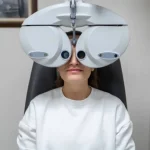For decades, millions of people across India—especially in low-income regions such as Bihar—have struggled to access quality healthcare. Among the many challenges faced, eye care has often remained out of reach. A lack of medical infrastructure, trained ophthalmologists, and public awareness has led to widespread vision problems that could have been prevented or treated early. Routine eye examinations, vital for maintaining good vision, were once a luxury for most rural families.
However, this scenario is now undergoing a major transformation. Bihar, one of India’s most underserved states in terms of healthcare, is emerging as an example of how technology can bridge long-standing gaps in medical access. With the rise of Artificial Intelligence (AI) and digital innovation, eye care in Bihar is becoming more efficient, precise, and inclusive. What was once limited to urban hospitals is now reaching railway stations, villages, and small towns—bringing hope and sight to people who need it most.
Dive deeper into insights that complement your interests—check this related post!
AI and the New Wave of Accessible Eye Care
AI is reshaping ophthalmology not only in Bihar but across India. Advanced AI-based systems can detect conditions such as cataract, diabetic retinopathy, and glaucoma within minutes by scanning retinal images and identifying early signs of disease. These technologies assist eye specialists by improving diagnostic speed and accuracy—helping ensure patients receive timely care before complications arise.
In regions like Bihar, where the ratio of eye specialists to patients remains critically low, this innovation is nothing short of transformative. Portable AI screening tools empower local healthcare workers to perform quick, high-quality eye tests even in remote areas. The results are then reviewed by ophthalmologists online, enabling real-time diagnosis and advice without the need for patients to travel long distances.
This blend of human expertise and machine precision is making preventive eye care possible on an unprecedented scale.
Bringing Eye Screenings to Public Spaces
One of the most significant examples of this change took place on World Sight Day, when a large-scale AI-enabled eye screening initiative was launched at major railway stations across Bihar. In collaboration with the Ministry of Railways, Government of India, AI-powered eye check-ups were conducted at Patna Junction, Rajendra Nagar Terminal, Hajipur, Patliputra, and Danapur Junction.
These busy railway stations were transformed into hubs of accessible healthcare. Thousands of passengers and railway personnel received quick, AI-assisted eye screenings—complete with instant reports and digital assessments. Those identified with potential eye issues were referred for further examination and treatment.
This approach demonstrated how technology can make preventive healthcare more inclusive by reaching people where they are, rather than expecting them to visit hospitals. For many in Bihar, this was their first-ever eye screening—achieved in minutes, without cost or travel.
Transforming the Eye Health Landscape in Bihar and Beyond
For years, eye care in Bihar and similar low-income regions of India followed a reactive model—patients would seek help only when vision loss became severe. The combination of distance, cost, and lack of awareness often resulted in late detection and irreversible blindness.
Now, AI and community-driven healthcare are changing that. The emphasis has shifted from treatment to early detection and prevention. Regular eye screenings are being made available through schools, local health centers, and even public transit locations. By embedding technology into community health programmes, organizations are helping to catch diseases early, before vision loss occurs.
This evolution signifies a broader movement: a transition from treating blindness to building a culture of proactive eye health.
Akhand Jyoti Eye Hospital: A Pioneer in Technological Eye Care
Leading this movement in Bihar is Akhand Jyoti Eye Hospital, widely recognized for its commitment to eliminating avoidable blindness in eastern India. Through its AI-powered “Healthy Eyes” initiative, the hospital has been integrating advanced screening technologies into its outreach programmes, enabling faster diagnosis and referral in underserved communities.
Its collaboration with the Ministry of Railways exemplifies how partnerships between government bodies and healthcare institutions can expand access to primary eye care. This initiative is not only a milestone for Bihar but also a model for other low-income regions across India—demonstrating that modern healthcare innovation can succeed even in resource-constrained settings.
Akhand Jyoti’s approach blends compassion, community engagement, and technology—making eye care both accessible and sustainable.
AI as an Enabler, Not a Replacement
The role of AI in healthcare is often misunderstood. Rather than replacing medical professionals, AI acts as an enabler—enhancing their efficiency and reach. In eye care, AI-powered systems can automate early-stage screenings, allowing ophthalmologists to focus on more complex cases and surgical care.
This collaboration between human expertise and artificial intelligence increases accuracy, reduces diagnostic delays, and minimizes human error. Early intervention—made possible by these technologies—can often mean the difference between restored vision and permanent sight loss.
Bridging India’s Urban–Rural Divide in Healthcare
In India, the divide between urban and rural healthcare has long been stark. Cities have specialized hospitals and doctors, while remote districts often lack even basic facilities. AI and tele-ophthalmology are now helping bridge this gap. Portable diagnostic tools, mobile eye clinics, and cloud-based platforms allow data and expertise to flow seamlessly from urban centers to rural communities.
For a predominantly rural state like Bihar—where nearly 90% of people live outside cities—this digital transformation is vital. Rural families can now receive timely diagnosis and referrals locally, without needing to travel to metropolitan hospitals. This advancement represents a step toward equitable healthcare access and a brighter future for millions living in low-income settings.
A Vision for the Future
The journey toward universal eye care in Bihar and other low-income regions of India is still ongoing, but the progress made so far is promising. Through technology, collaboration, and innovation, what once seemed unreachable is becoming possible—affordable, high-quality eye care for all.
Organizations such as Akhand Jyoti Eye Hospital, supported by visionary government partnerships and powered by AI, are setting new standards for inclusive healthcare delivery. These initiatives show that when science meets empathy, even the most underserved communities can experience lasting change.
Bihar’s story is, in essence, a story of hope—a reminder that with innovation and compassion, every individual deserves the right to see a clearer, brighter world.
Spotlight on the latest trends—don’t miss this must-read featured post!







